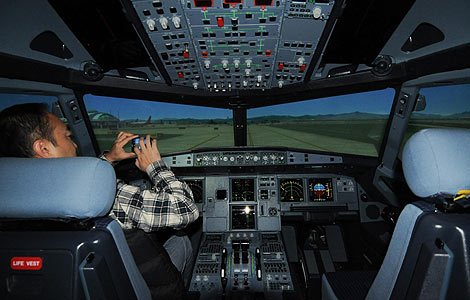
Faced with the global aviation industry downturn, Chinese airlines are being forced to compete among themselves in increasingly innovative ways.
In Western Europe and North America, many airlines have recently reported worse-than-expected losses. In China, the country's international carrier Air China saw its profits fall 38 percent last year.
However, two other large airlines - China Eastern and China Southern, in which the State holds controlling stakes - still managed to expand using innovative strategies.
China Southern Airlines, which claims to be the largest airline by passenger capacities in Asia and the fifth-largest in the world, is leveraging its extensive domestic service network and its transit hub in Guangzhou, to provide customers with a convenient connection between international and domestic services.
At a time when most developed economies are suffering from a lingering crisis, more Chinese people are traveling abroad for tourism and business.
"Now is a good time for our business to go abroad," said Si Xianmin, China Southern's chairman, in an interview with China Daily.
After launching six international service routes last year, China Southern started direct flights from Guangzhou to London in June, connecting wealthy travelers from China's southern provinces with European destinations.
"We're aiming to increase international routes to 30 percent of our company's total routes this year, up from 27 percent last year," Si said.
Compared with other major Chinese airlines, China Southern's advantage is its mature domestic network, Si said. It now operates around 200 domestic routes, more than the other two major State-owned airlines, Air China and China Eastern.
Thanks to its comprehensive domestic network, China Southern can attract more passengers from the second and third-tier cities, where other airlines have no direct flights, Si added.
As a result, Guangzhou Baiyun International Airport — China Southern's home base — has become one of the country's major transit hubs. In 2011, it was China's second-busiest airport and the world's 19th busiest in terms of passenger traffic, with more than 45 million passengers handled.
The company forecasts a soaring passenger load factor, a measure of the utilization of the total capacity of its planes, on international flights, Si said.
In 2010, when China Southern launched its route to Australia, it saw its passenger numbers increase by 97 percent in a year, with its passenger load factor rising from 54 percent to 78 percent, enabling the company's total international revenue to surge 48 percent year-on-year.
China's air travel market is around 300 million passengers a year, and the figure is expected to grow to 450 million in three years.
Meanwhile, the strategy of Shanghai-based China Eastern Airlines is to seek growth through international cooperation.
The airline is working with Australia's Qantas to launch Hong Kong's first budget airline.
Jetstar Hong Kong will be a $198 million joint venture in which Qantas and China Eastern will hold equal stakes. It plans to start flying next year.
Liu Shaoyong, China Eastern's chairman, said the Qantas JV is a key step in the company's globalization.
However, it is still too early to tell whether China Eastern will succeed in this part of the world, where the concept of budget travel is still new.
Contact the writer at baochang@chinadaily.com.cn.







